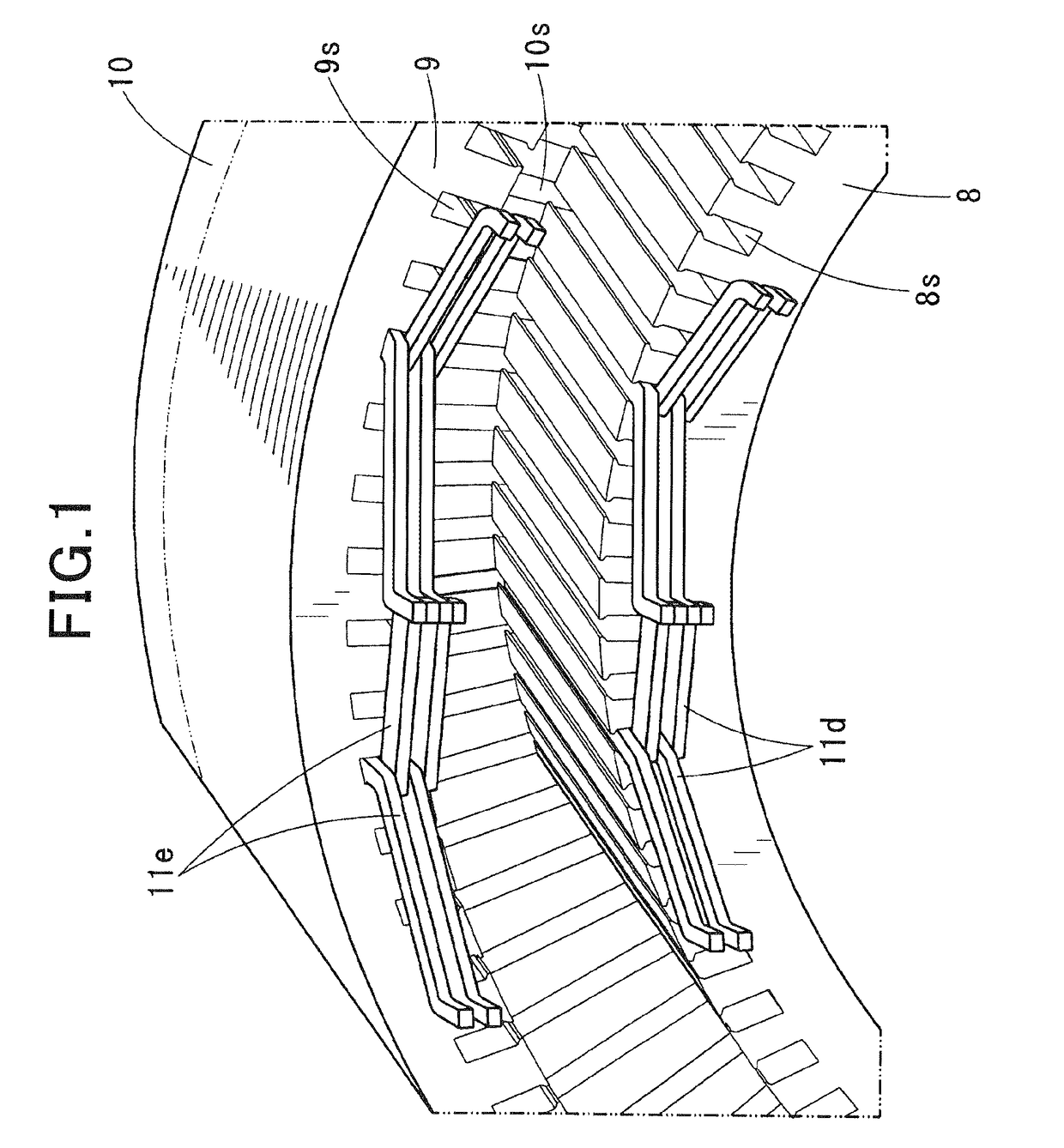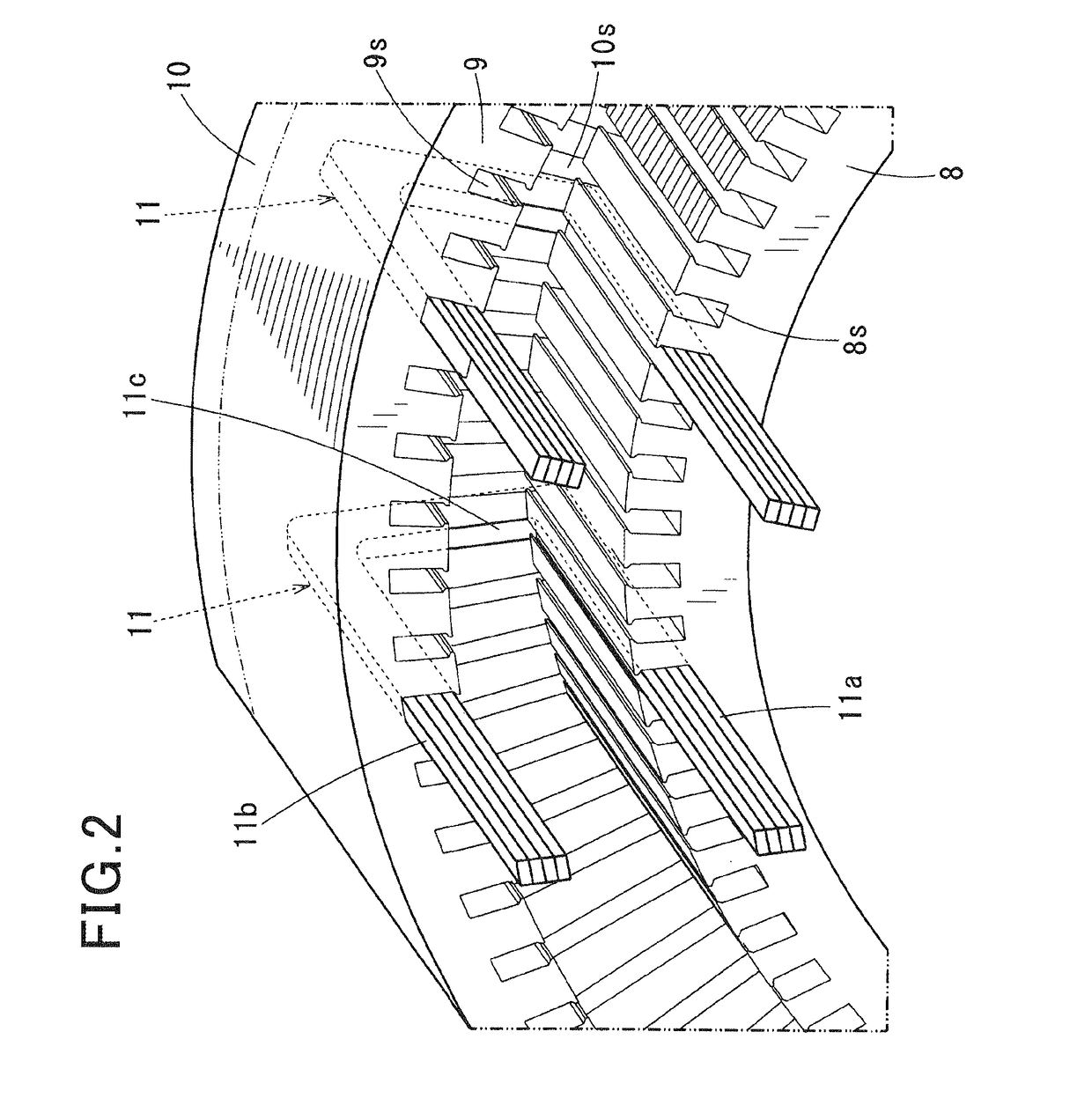Multi-gap rotating electric machine having phase coils formed of substantially U-shaped electric conductor segments
a technology of phase coils and electric conductor segments, which is applied in the direction of dynamo-electric machines, magnetic circuit rotating parts, magnetic circuit shape/form/construction, etc., can solve the problems of increasing manufacturing costs, and achieve the effect of effectively suppressing the torque ripple of the rotating electric machin
- Summary
- Abstract
- Description
- Claims
- Application Information
AI Technical Summary
Benefits of technology
Problems solved by technology
Method used
Image
Examples
first embodiment
[0031]FIG. 6 shows the overall configuration of a multi-gap rotating electric machine according to a first embodiment.
[0032]In this embodiment, the multi-gap rotating electric machine is configured as a traction motor 1 to be arranged between an engine and a transmission in a hybrid vehicle.
[0033]As shown inFIG. 6, the motor 1 includes: a motor housing 2; a rotating shaft 4 that is rotatably supported by the motor housing 2 via a pair of bearings 3; an annular rotor 6 that is supported by the rotating shaft 4 via a rotor disc 5; a stator core that is fixed to the motor housing 2 and will be described in detail later; and a three-phase stator coil 7 mounted on the stator core.
[0034]The rotating shaft 4 is configured to be coupled to a crankshaft (not shown) of the engine either directly or via a clutch (not shown).
[0035]The rotor disc 5 is made, for example, of a nonmagnetic stainless steel. The rotor disc 5 is fitted on the outer periphery of the rotating shaft 4 so as to support th...
second embodiment
[0070]This embodiment illustrates a multi-gap rotating electric machine which has a similar configuration to the multi-gap rotating electric machine (i.e., the motor 1) according to the first embodiment; accordingly, only the differences therebetween will be described hereinafter.
[0071]In the first embodiment, the side core part 10 of the stator core has the slots 10s formed therein, so that part of the electric conductor segments 11 have their respective connecting portions 11c received in the corresponding slots 10s of the side core part 10 (see FIGS. 4-5).
[0072]In comparison, in the present embodiment, as shown in FIG. 7, the side core part 10 of the stator core has no slots formed therein. Instead, the stator core part 10 is arranged on the one axial side (i.e., the left side in FIG. 7) of the rotor 6 so as to abut the connecting portions 11c of the electric conductor segments 11 that have their respective first and second leg portions 11a and 11b inserted in the corresponding s...
third embodiment
[0075]This embodiment illustrates a multi-gap rotating electric machine which has a similar configuration to the multi-gap rotating electric machine according to the first embodiment; accordingly, only the differences therebetween will be described hereinafter.
[0076]In the first embodiment, the stator coil 7 is comprised of the three phase coils that are star-connected to each other. In other words, the stator coil 7 includes only the single set of three phase coils.
[0077]In comparison, in the present embodiment, as shown in FIG. 8, the stator coil 7 is comprised of a first set of U-phase, V-phase and W-phase coils (to be referred to as a first coil unit 7A of the stator coil 7 hereinafter) and a second set of U-phase, V-phase and W-phase coils (to be referred to as a second coil unit 7B of the stator coil 7 hereinafter).
[0078]The U-phase, V-phase and W-phase coils of the first coil unit 7A of the stator coil 7 are star-connected to each other. The U-phase, V-phase and W-phase coils...
PUM
 Login to View More
Login to View More Abstract
Description
Claims
Application Information
 Login to View More
Login to View More - R&D
- Intellectual Property
- Life Sciences
- Materials
- Tech Scout
- Unparalleled Data Quality
- Higher Quality Content
- 60% Fewer Hallucinations
Browse by: Latest US Patents, China's latest patents, Technical Efficacy Thesaurus, Application Domain, Technology Topic, Popular Technical Reports.
© 2025 PatSnap. All rights reserved.Legal|Privacy policy|Modern Slavery Act Transparency Statement|Sitemap|About US| Contact US: help@patsnap.com



